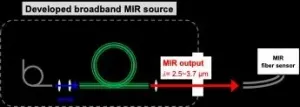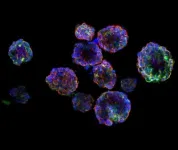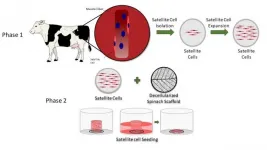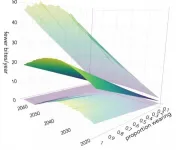Development of a broadband mid-infrared source for remote sensing
2021-03-31
(Press-News.org) A research team of the National Institutes of Natural Sciences, National Institute for Fusion Science and Akita Prefectural University have successfully demonstrated a broadband mid-infrared (MIR) source with a simple configuration. This light source generates highly-stable broadband MIR beam at 2.5-3.7 μm wavelength range maintaining the brightness owing to its high-beam quality. Such a broadband MIR source facilitates a simplified environmental monitoring system by constructing a MIR fiber-optic sensor, which has the potential for industrial and medical applications.
In the MIR wavelength region, there are many strong absorption lines of molecules due to the change of their rotational and vibrational states. Therefore, by using MIR sources, we have promising opportunities to develop sensitive remote monitoring systems of practical use. In particular, a fiber-optic sensor based on MIR absorption spectroscopy has great potential as the next-generation gas detecting device, e.g., for an exhaust gas monitor at an industrial plant, breath analysis for medical purposes, and other uses. However, there is the remaining issue of the absence of a suitable MIR source exhibiting broadband spectrum and high-beam quality. In this work, the research team has demonstrated an ultra-broadband amplified spontaneous emission (ASE) source at the MIR region, which meets the requirements for developing the fiber-optic sensor.
In order to obtain the MIR emission, the research team has developed optical fiber made of fluoride glass co-doped with trivalent ions of Er (the atomic number 68) and Dy (66). This fiber enables a simple and low-cost configuration of ASE light source with diode-pumping (Fig. 1) by means of energy transfer from Er^3+ to Dy^3+. A broadband and moderate-power ASE light source of 2.5-3.7 μm wavelength (Fig. 2) was experimentally investigated for the optimum design of fluoride fiber in terms of ion concentration, fiber length, pumping configuration, and pumping power. In addition, this light source exhibits excellent beam quality resulting in high-coupling efficiency with an external optical fiber.
Assistant Professor Hiyori Uehara in the research team states that, "Our new light source can facilitate a simplified MIR fiber-optic sensor device for various practical applications. For example, an environmental monitoring system in the industrial plant, stand-off detection of hazardous objects, disease diagnosis by breath analysis, inspection of fiber-optic devices, and others. Ongoing detailed research demonstrating highly-sensitive multiple-gas detection using a MIR fiber sensor will be performed and reported in the near future."
INFORMATION:
Science Contact:
Dr. Hiyori Uehara, NIFS Assistant Professor
uehara.hiyori@nifs.ac.jp
[Attachments] See images for this press release:

ELSE PRESS RELEASES FROM THIS DATE:
2021-03-31
A*STAR's Institute of Bioengineering and Nanotechnology (IBN) has teamed up with Singapore Institute of Advanced Medicine Holdings Pte Ltd (SIAMH) to establish the first of its kind in-vitro patient-derived 3D organoid models of Nasopharyngeal Cancer (NPC).
The study was published in Frontiers in Oncology on 23 February 2021. It is the first direct experimental evidence to predict optimal Radiation Treatment (RT) boost dose required to cause sufficient damage to recurrent hypoxic (low oxygen level) NPC tumour cells, which can be further used to develop dose-painting algorithms in clinical practice.
Two patient-derived xenograft (PDX) ...
2021-03-31
Researchers from Loyola Marymount University, San Diego State University, Indian Institute of Management, and Iowa State University published a new paper in the Journal of Marketing that examines how effective marketplace participation by subsistence consumers requires knowledge and skills that relate to what, how, and why to participate.
The study, forthcoming in the Journal of Marketing, is titled "Marketplace Literacy as a Pathway to a Better World: Evidence from Field Experiments in Low-Access Subsistence Marketplaces" and is authored by Madhu Viswanathan, Nita Umashankar, Arun Sreekumar, and Ashley Goreczny.
Success for marketers looking to emerging markets for growth is inextricably ...
2021-03-31
COLUMBUS, Ohio - Bangladesh's floating gardens, built to grow food during flood seasons, could offer a sustainable solution for parts of the world prone to flooding because of climate change, a new study has found.
The study, published recently in the Journal of Agriculture, Food and Environment, suggests that floating gardens might not only help reduce food insecurity, but could also provide income for rural households in flood-prone parts of Bangladesh.
"We are focused here on adaptive change for people who are victims of climate change, but who did not cause climate ...
2021-03-31
PULLMAN, Wash. -- Nature's strongest material now has some stiff competition. For the first time, researchers have hard evidence that human-made hexagonal diamonds are stiffer than the common cubic diamonds found in nature and often used in jewelry.
Named for their six-sided crystal structure, hexagonal diamonds have been found at some meteorite impact sites, and others have been made briefly in labs, but these were either too small or had too short of an existence to be measured.
Now scientists at Washington State University's Institute for Shock Physics created hexagonal diamonds large enough to measure ...
2021-03-31
Chestnut Hill, Mass. (3/31/21) -- Spinach, a cost-efficient and environmentally friendly scaffold, provided an edible platform upon which a team of researchers led by a Boston College engineer has grown meat cells, an advance that may accelerate the development of cultured meat, according to a new report in the advance online edition of the journal Food BioScience.
Stripped of all but its veiny skeleton, the circulatory network of a spinach leaf successfully served as an edible substrate upon which the researchers grew bovine animal protein, said Boston College Professor of Engineering Glenn Gaudette, the lead author of the new study. The results may help increase the production of cellular agriculture ...
2021-03-31
Research published today in the peer-reviewed Journal of Vertebrate Paleontology describes a newly discovered species of dinosaur - named the 'one who causes fear', or Llukalkan aliocranianus.
Around 80 million years ago as tyrannosaurs ruled the Northern Hemisphere, this lookalike was one of 10 currently known species of abelisaurids flourishing in the southern continents.
A fearsome killer, Llukalkan was "likely among the top predators" throughout Patagonia, now in Argentina, during the Late Cretaceous due to its formidable size (up to five meters long), extremely powerful ...
2021-03-31
Early treatment with anti-VEGF injections slowed diabetic retinopathy in a clinical study from the DRCR Retina Network (DRCR.net). However, two years into the four-year study its effect on vision was similar to standard treatment, which usually begins at the onset of late disease. The intermediate findings published today in the JAMA Ophthalmology. The study was supported by the National Eye Institute (NEI), a part of the National Institutes of Health.
"While it is possible that preventive injections of anti-VEGF drugs may help protect vision in the longer-term, ...
2021-03-31
A new mathematical model suggests that the easing of lockdown must be accompanied by wider and more effective use of control measures such as facemasks even with vaccination, in order to suppress COVID-19 more quickly and reduce the likelihood of another lockdown.
The model, developed by scientists at the Universities of Cambridge and Liverpool, is published today in the Journal of the Royal Society Interface. It uses mathematical equations to provide general insights about how COVID-19 will spread under different potential control scenarios.
Control measures involving facemasks, handwashing and short-scale (1-2 metre) social distancing can all limit the number of virus particles being spread between people. These are termed ...
2021-03-31
With shark bites increasing in countries like Australia - scientists say the use of personal electronic deterrents is an effective way to prevent future deaths and injuries which could save the lives of up to 1063 Australians along the coastline over the next 50 years.
The research, published in scientific journal Royal Society Open Science, shows that while shark bites are rare events, strategies to reduce shark-bite risk are also valuable because they can severely affect victims and their support groups - with one third of victims experiencing post-traumatic stress ...
2021-03-31
Heart attacks in young adults are twice as likely to be fatal in those with inflammatory conditions like psoriasis, lupus or rheumatoid arthritis. That's the finding of a study published today in the European Journal of Preventive Cardiology, a journal of the European Society of Cardiology (ESC).1
At least 2% of people in Europe and worldwide have systemic inflammatory diseases, which often affect multiple organ systems. Many of these systemic inflammatory diseases are driven by autoimmunity, meaning the body's immune system attacks itself. Psoriasis is the most common and causes red, itchy, scaly patches on the skin, and can also cause inflammation in the joints. Rheumatoid arthritis leads to inflammation in joints of the hands and feet and in other organ systems. In systemic ...
LAST 30 PRESS RELEASES:
[Press-News.org] Development of a broadband mid-infrared source for remote sensing




